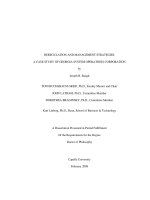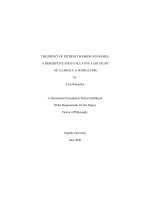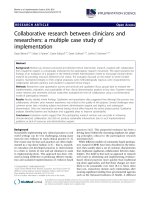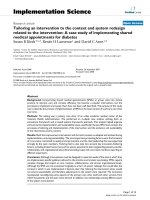culture comparison and culture change case study of abb vietnam and abb singapore
Bạn đang xem bản rút gọn của tài liệu. Xem và tải ngay bản đầy đủ của tài liệu tại đây (2 MB, 129 trang )
TABLE OF CONTENT
ACKNOWLEDEMENTS .................................................................................................... i
ABSTRACT .......................................................................................................................... ii
TÓM TẮT ............................................................................................................................ iv
TABLE OF CONTENT...................................................................................................... vi
LIST OF TABLES .............................................................................................................. ix
LIST OF FIGURES ............................................................................................................. x
INTRODUCTION ............................................................................................................... 1
CHAPTER 1: LITERATURE REVIEW .......................................................................... 3
1.1.
Definitions .............................................................................................................. 3
1.1.1.
Culture ............................................................................................................. 3
1.1.2.
Organizational Culture ..................................................................................... 5
1.2.
Cultural layers & cultural diversity .................................................................... 6
1.2.1.
The out layer (Explicit Products/Artifacts) ...................................................... 8
1.2.2.
The middle layer (Norms and Beliefs/Espoused Beliefs and Values) ................. 10
1.2.3.
The core (Basic Assumptions/Underlying Assumptions) .............................. 11
1.3.
Sub-culture........................................................................................................... 15
1.4.
The importance of organizational culture ........................................................ 15
1.4.1.
Coordination .................................................................................................. 16
1.4.2.
Integration ...................................................................................................... 17
1.4.3.
Motivation ...................................................................................................... 18
1.4.4.
How well can organizational culture do its functions? .................................. 18
1.5.
Culture analysis – OCAI method....................................................................... 19
1.5.1.
General about culture analysis methods ........................................................ 19
vi
1.5.2.
Advantages of OCAI method ........................................................................ 24
1.5.3.
Dimensions in OCAI ..................................................................................... 25
1.5.4.
Questionnaire applied in OCAI ..................................................................... 27
1.5.5.
Scoring the OCAI .......................................................................................... 28
1.5.6.
What can be found from OCAI result ............................................................ 28
1.6.
Methodology applied in the thesis ..................................................................... 37
1.6.1.
OCAI method ................................................................................................. 37
1.6.2.
Interview method ........................................................................................... 37
1.6.3.
Other analysis methods .................................................................................. 38
1.6.4.
Focused points ............................................................................................... 38
CHAPTER 2: CULTURE ANALYSIS IN ABB PP DIVISIONS ................................. 39
2.1.
Introduction about ABB Singapore and ABB Vietnam .................................. 39
2.1.1.
Introduction about ABB Group ..................................................................... 39
2.1.2.
Introduction about ABB Vietnam (VNABB) and ABB Singapore (SGABB) ..
....................................................................................................................... 42
2.2.
Organizational culture comparison between SGABB’s and VNABB’s PP
Division ............................................................................................................................ 45
2.2.1.
Different dominant cultures but same major culture types ............................ 45
2.2.2.
The current dominant culture gains cultural congruence in both countries ... 48
2.2.3.
Differences in expected dominant culture types ............................................ 53
2.2.4.
Less cultural congruence for the expected dominant cultures & the inevitable
emergence of Clan and Adhocracy............................................................................... 54
2.2.5.
2.3.
Diversity in expectation of employee groups ................................................ 58
Factors influencing organizational cultures in the two Divisions ................... 60
2.3.1.
The vital role of standardization in ABB‟s operation .................................... 60
2.3.2.
Market situation and market orientation in ABB Group ............................... 62
vii
2.3.3.
Asian culture – a strong factor supporting for Clan Culture.......................... 66
2.3.4.
Adhocracy Culture – an answer to the dilemmas .......................................... 66
2.3.5.
Business nature & the major sub-groups ....................................................... 66
CHAPTER 3: RECOMMENDATIONS .......................................................................... 68
3.1.
The importance of defining culture profile ....................................................... 68
3.2.
Culture incongruence requires leadership involvement .................................. 68
3.2.1.
Leaders are to listen and respect the needs of employees. ............................. 69
3.2.2.
Vision the future culture to pursuit ................................................................ 69
3.2.3.
Define the culture transformation process ..................................................... 70
3.3.
Visioning the transformation ............................................................................. 70
3.3.1.
ABB Vietnam – PP Division ......................................................................... 71
3.3.2.
ABB Singapore – PP Division ....................................................................... 75
3.4.
Operational change for the cultural change ..................................................... 79
3.4.1.
In ABB Vietnam – PP Division ..................................................................... 79
3.4.2.
In ABB Singapore – PP Division .................................................................. 83
3.5.
International cooperation and global resource utilization .............................. 88
CONCLUSION .................................................................................................................. 91
REFERENCE ..................................................................................................................... 93
APPENDIX 1: VARIOUS CATEGORIES USED TO DESCRIBE CULTURE ............... 97
APPENDIX 2: ENVIRONMENTAL VARIABLES AFFECTING MANAGEMENT
FUCTIONS .......................................................................................................................... 99
APPENDIX 3: DENISON ORGANIZATIONAL CULTURE SURVEY ........................ 100
APPENDIX 4: QUESTIONAIRE SAMPLE .................................................................... 101
APPENDIX 5: CULTURE PROFILE COMPARISION
VIETNAM VS. SINGAPORE
........................................................................................................................................... 105
viii
LIST OF TABLES
TABLE 1-1: BONUS PERSPECTIVE IN INDIVIDUALISM AND COLLECTIVISM .. 13
TABLE 1-2: AMERICA VALUES AND POSSIBLE ALTERNATIVES ......................... 14
TABLE 1-3: COMPARISION BETWEEN OCAI METHOD AND OTHER METHODS 24
TABLE 1-4: EXAMPLE OF SCORING FOR CATEGORY DOMINANT
CHARACTERISTIC ........................................................................................................... 28
TABLE 1-5: SAMPLE SIZE IN THE TWO DIVISIONS .................................................. 37
TABLE 2-1: ABB GROUP‟S KEY INFORMATION........................................................ 39
TABLE 2-2: CHARACTERISTIC OF EACH EMPLOYEE GROUP ............................... 43
TABLE 2-3: DATA TABLE - VIETNAM PP DIVISION - PRESENT CULTURE AND
PREFERED CULTURE THROUGH 6 CATEGRIES ....................................................... 55
TABLE 2-4: DATA TABLE - SINGAPORE PP DIVISION - PRESENT CULTURE AND
PREFERED CULTURE THROUGH 6 CATEGRIES ....................................................... 57
TABLE2-5: COMPARISION BETWEEN SGABB PP DIVISION & VNABB ................ 67
TABLE 3-1: VIETNAM PP DIVISION - EXPECTATION FOR MAJOR CHANGE...... 72
TABLE 3-2: SINGAPORE PP DIVISION - EXPECTATION FOR MAJOR CHANGE.. 76
TABLE 3-3: ACTION PLAN FOR VIETNAM PP DIVISION ......................................... 81
TABLE 3-4: ACTION PLAN FOR SINGAPORE PP DIVISION ..................................... 86
ix
LIST OF FIGURES
FIGURE 1-1: MODEL OF CULTURE – FONS TROMPENAARS .................................... 7
FIGURE 1-2: LEVEL OF CULTURE - SCHEIN................................................................. 7
FIGURE 1-3: ICE-BERG MODEL .................................................................................... 18
FIGURE 1-4: INDIVIDUALISM RANKING .................................................................... 21
FIGURE 1-5: THE COMPETING VALUES FRAMEWORK ........................................... 26
FIGURE 1-6: THE COMPETING VALUES OF LEADERSHIP, EFFECTIVENESS,
AND ORGANIZATIONAL THEORY ............................................................................... 33
FIGURE 1-7: ERICSSON'S CULTURAL PROFILE ......................................................... 36
FIGURE 2-1: ABB STRUCTURE ...................................................................................... 41
FIGURE 2-2: PROPORTION OF EACH EMPLOYEE GROUP IN THE TWO PP
DIVISIONS ......................................................................................................................... 44
FIGURE 2-3: NUMBER OF EMPLOYEES IN VNABB PP DIVISION AND SGABB PP
DIVISION ............................................................................................................................ 45
FIGURE 2-4: VIETNAM PP DIVISION‟S CULTURE PROFILE .................................... 46
FIGURE 2-5: SINGAPORE PP DIVISION‟S CULTURE PROFILE ................................ 47
FIGURE 2-6: PRESENT ASSESSMENT THROUGH 6 CATEGORIES IN VIETNAM PP
DIVISION ............................................................................................................................ 48
FIGURE 2-7: PRESENT ASSESSMENT THROUGH 6 CATEGORIES IN SINGAPORE
PP DIVISION ...................................................................................................................... 49
FIGURE 2-8: SAMPLE DESCRIPTIVE ANALYSIS VIETNAM PP DIVISION ............ 50
FIGURE 2-9: CURRENT ASSESSMENT OF EACH EMPOYEE GROUP ..................... 51
FIGURE 2-10: SAMPLE DESCRIPTIVE ANALYSIS SINGAPORE PP DIVISION ...... 51
FIGURE 2-11: CURRENT ASSESSMENT OF EACH EMPOYEE GROUP ................... 52
x
FIGURE 2-12: VIETNAM PP DIVISION - PRESENT CULTURE AND PREFERED
CULTURE THROUGH 6 CATEGRIES ............................................................................ 55
FIGURE2-13: ABB SINGAPORE PP DIVISION - PRESENT CULTURE AND
PREFERED CULTURE THROUGH 6 CATEGRIES ....................................................... 56
FIGURE 2-14: ABB VIETNAM PP DIVISION - PRESENT ASSESSMENT AND
FUTURE EXPECTATION OF EMPLOYEE GROUPS .................................................... 58
FIGURE 2-15: SINGAPORE PP DIVISION - PRESENT ASSESSMENT AND FUTURE
EXPECTATION OF EMPLOYEE GROUPS ..................................................................... 59
FIGURE 2-16: OVERVIEW OF 2011 – 2015 DIVISIONAL TARGETS ......................... 62
FIGURE 2-17: REVENUES AND OPERATIONAL EBITDA BY DIVISION ................ 63
FIGURE 2-18: ABB‟S BUSINESSES BY DIVISION AND REGION 2011 .................... 63
FIGURE 2-19: ORDER GROWTH BY REGION 2010 VS 2011 ...................................... 64
FIGURE 2-20: GROWTH RATES ACROSS ALL DIVISIONS ....................................... 65
FIGURE 3-1: VNABB PP DIVISION - MANAGEMENT APPROACH .......................... 71
FIGURE 3-2: SGABB PP DIVISION - MANAGEMENT APPROACH COMPARED
WITH GENERAL APPROACH ......................................................................................... 75
xi
INTRODUCTION
1. Purpose
The thesis focuses on the following points:
-
Base on Organizational Culture Assessment Instrument to find out the
cultural similarities and differences in the two Divisions in ABB Vietnam
and ABB Singapore in terms of dominant cultures, culture congruence,
expected dominant culture and factors that drives the needs for culture
change.
-
Define predominant factors that should be taken into consideration for
culture change so as to increase business performance
-
Give recommendation for cultural change including action plan for each
Division.
2. The research scope
There are two defined research scope dimensions in this thesis to distribute a
solid analysis and practical recommendation
-
The factors to compare between the two Divisions are concentrated on six
categories: (1) Dominant Characteristic, (2) Leadership Style, (3)
Management of Employees, (4) Organizational Glue, (5) Strategy Emphases
and (6) Criteria of Success
-
The cultural comparison units are ABB Singapore‟s and ABB Vietnam‟s
Power Product Division.
3. Methodology
-
The thesis use both quantitative and qualitative analysis, mainly based on
OCAI method.
-
The information is collected from diverse sources: survey, interview,
observation, secondary data…
-
Details are mentioned in 2.2 Applied method in the thesis
1
Structure of the thesis
Literature
Review
Culture analysis
in ABB PP
Divisions
Recommendation
Definitions of Culture
and Organizational
Culture
Introduction about
ABB Singapore &
ABB Vietnam
The importance of
defining culture profile
Cultural layer and
cultural diversity
Applied methods in
the thesis
As culture
incongruence occurs,
leadership involves
Sub-culture
Organizational
Culture comparison
Visioning the
transformation
The importance of
Organizational
Culture
Factors influencing
the organizational
cultures
Operational change for
the culture change
International
cooperation and global
resource utilization
Culture analysis
2
CHAPTER 1: LITERATURE REVIEW
1.1. Definitions
1.1.1. Culture
Culture is a concept has had a long and checkered history and because of its
broad meaning, it has been used by numerous ways. The layman can use
culture as a word to indicate sophistication, as when we say that someone is very
“cultured.” Anthropologists use it for referring to the customs and rituals that
societies develop over the course of their history. In the last several decades it has
been used by some organizational researchers and managers to refer to the climate
and practices that organizations develop around their handling of people, or to the
espoused values and credo of an organization.
In a common sense, culture is defined in the Cambridge Dictionary as “the way
of life, especially the general customs and beliefs, of a particular group of people at
a particular time”1. It can be interpreted from the above definition by the following
points:
The way of life, general customs and belief: in that term, culture influences
people‟s behaviors so deeply that hardly can a member who lives in this culture can
be aware of that.
Particular group of people: culture is always related to a group of people, not
individual.
Particular time: upon periods of times, culture haves different contents.
A further step to enlarge the concept of culture beyond “custom” and “belief” is
given by Edward B.Tylor who stated culture is “complex whole which includes
knowledge, belief, art, morals, law, custom, and any other capabilities and habits
acquired by man as a member of society" 2 . There are critical points in the
definition:
1
Cambridge Online Dictionary, />Truman State University, Invitation to Cultural Evolutionism, Founding Figures, Edward Tylor,
/>2
3
Complex whole: Culture is not a set of discrete things, it is a system.
Capabilities and habits acquired: Culture includes of capabilities and habits
which belong to a member of society.
Member of society: Similar to the above definition, culture always attaches to a
group of people, not an individual.
As the above definitions can show the wide connotation of culture, however,
they just stop mainly at enumerating culture‟s elements without figuring out which
is the culure‟s core impact. Come to Geert Hosfstede‟s time, the concept of culture
is generalized and given a solid understanding. Geert Hosfstede3 is a well-know
pioneer for his research of cross-cultural groups and organizations. He has played a
major role in developing a systematic framework for assessing and differentiating
national cultures and organizational cultures. According to his definition, “Culture
is the collective programming of the human mind that distinguishes the members of
one human group from those of another. Culture in this sense is a system of
collectively held values.” Following are remarkable notes in his definitions:
Collective programming of the human mind: culture is mentioned as a mindset
which is shared among a group of people. It is like “programming” or unwritten
rules whereby the members of this group have a common way of receiving and
processing information.
Distinguishes human group: Culture is different from each group to another
group. Culture itself is a tool to distinguish human groups. And once again, culture
is a concept attaching to a group of human, not an individual.
System of collectively held values: Culture is not just a set of common things; it
is a system of values which is collectively held for a period of time. "Culture" is
how we call these unwritten rules about how to be a good member of the
group. Culture provides moral standards about how to be an upstanding group
member; it defines the group as a "moral circle".4
3
4
/> />
4
1.1.2. Organizational Culture
From the above definitions, it can be understood that the most intriguing aspect
of culture as a concept is that it points us to phenomena that are below the surface,
that are powerful in their impact but invisible and to a considerable degree
unconscious. Culture as a concept will be most useful if it helps us to better
understand the hidden and complex aspects of life in groups, organizations, and
occupations.
Based on that concept, many researcher have been focusing on culture within an
organization, hence the concept of “organizational culture” has been established.
For example, H.Schwartz and S.Davis stated culture as “a pattern of beliefs and
expectations shared by organization‟s members. These beliefs and expectations
produce norms that powerfully shape the behaviour of individuals and groups”. 5
Another definition is from Deal and Kennedy who pointed culture as “espoused
values” - the articulated, publicly announced principles and values that the group
claims to be trying to achieve, such as “product quality” or “price leadership” . In
general, numerous of terms are used such as “shared meanings”, “root metaphors”,
“rules of the game”, “group norms”… (Appendix 1: VARIOUS CATEGORIES USED
TO DESCRIBE CULTURE) and all of these manifest the strong impact of culture and
organizational culture.
This thesis used the definition of Edgar H.Schein for Organizational Culture:
The culture of a group can now be defined as a pattern of shared basic
assumptions that was learned by a group as it solved its problems of external
adaptation and internal integration, that has worked well enough to be considered
valid and, therefore, to be taught to new members as the correct way to perceive,
think, and feel in relation to those problems.6
With the definition, there are critical points to understand about organizational
culture:
5
John L. Thompson, Frank Martin, “Strategic management: awareness and change”, 5th edition, Thomson
Learning, 2005, pg.377
6
Edgar H.Schein, “Organizational Culture and Leadership”, Jossey Bass, Third Edition, 2004, page.17
5
Pattern of shared basic assumptions: This is the critical aspect of culture, it means
that certain things in groups are shared or held in common but they are so deep that
all the members of that group just take it for granted.
Group: it is noticeable that “group” not “crowd” or “collection of people” is used.
It follows that any group needs a certain level of stability in membership and a
history of shared learning to develop some level of culture, but a group that has had
either considerable turnover of members and leaders or a history lacking in any kind
of challenging events may well lack any shared assumptions.
Learned by a group as it solved its problems of external adaptation and internal
integration: All group and organizational theories distinguish two major sets of
problems that all groups, no matter what their size, must deal with: (1) survival,
growth, and adaptation in their environment; and (2) internal integration that
permits daily functioning and the ability to adapt and learn. Both of these areas of
group functioning will reflect the larger cultural context in which the group exists
and from which are derived broader and deeper basic assumptions, for examples,
about the nature of reality, time, space, human nature, and human relationships.
1.2. Cultural layers & cultural diversity
Culture is like gravity: you do not experience it
until you jump six feet into the air.7
Fons Trompenaars and Charles Hampden- Turner
As mentioned in the Definitions part, culture is “collective programming” or
“shared basic assumptions” so it is taken for granted by people absorbing this
culture. People normally just realize their culture when they jump into another
culture and realize how different between their familiar culture and the new one.
Cultures differ from each other in many levels, from absolutely visible points to
deeply profound factors. Researchers categories cultures into many levels. For
examples, Fons Trompenaars divides culture into 3 levels which are the out layer 7
Fons Trompenaars & Charles Hampden-Turner, “Riding the waves of cultures – Understanding cultural
diversity in business”, Nicholas Brealey Publishing, London, 2nd edition, 1998, pg.5
6
Explicit Products, the middle layer - Norms and Values, the core - Basis
Assumptions while Schein categorizes culture into 3 level: Artifacts, Espoused
Beliefs and Values, Underlying Assumptions.
FIGURE 0-1: MODEL OF CULTURE – FONS TROMPENAARS8
Basic
Assumptions
Norms and Values
Explicit Products
FIGURE 0-2: LEVEL OF CULTURE - SCHEIN9
Artifacts
Visible organizational structures
and processes
(hard to decipher)
Espoused Beliefs
and Values
Strategies, goals, philosophies
(espoused justifications)
Unconscious, taken-for-granted beliefs,
perceptions, thoughts, and feelings. . .
(ultimate source of values and action)
Underlying
Assumptions
While the two researchers used different terms to categorize layers of culture,
there are critical common points in their view.
8
Fons Trompenaars & Charles Hampden-Turner, “Riding the waves of cultures – Understanding cultural
diversity in business”, Nicholas Brealey Publishing, London, 2nd edition, 1998, pg.21
9
Edgar H. Schein, “Organizational Culture and Leadership”, Jossey-Bass, USA, 3rd edition, 2004, pg. 26
7
First, about the influences and how easy to realize one layer, the out layer of
culture is easy to realize but difficult to decipher as it is the outcome of deeper
layers. The deeper of the layer, the stronger influence it has but it is more difficult
to be realized. When it comes to the core layer, there are few profound assumptions
which are taken for granted and decode all the factors in remaining layers. For
example, why staff in a hospital always stick with rules and procedures when
designers in an IT company just talk about new ideas, new concepts? Dig down into
a deeper layer, we can see that with a hospital, its professional standard is hygiene,
safe and secure where people lives can be taken with one slight mistake, therefore,
rules and procedures are strictly follow to minimize the risk. In contrary, IT
company defines success as high speed in giving new products or service that
motivates its employee to be creative and innovative for new concepts and ideas.
Second, in term of cultural diversity and how can people accept culture
differences, the level of diversity and acceptance varies through cultural layers. The
diversity in every single layer, then the combination of all the differences in all
layers leads to cultural diversity and cultural conflicts also. In the out layer, with its
apparentness, the layer shows numerous obvious and incoherent differences
between cultures and can make a new comer easily feel overwhelmed. Luckily, to a
certain level, people still can accept these differences when they are aware of that.
For example, if a person changes his job from a financial institute to an
entertainment company, he can change his style from tie and vest to T-shirt and
jeans or he can enjoy a flexible working time instead of a fixed working time.
However, to deeper level, even when the differences are figured out or verbalized,
they are still difficult to be accepted as they already became “philosophy”, “rules”,
“correct or wrong” in mindset of people. This difference in the level is indeed the
factor lead to cultural conflicts.
1.2.1. The out layer (Explicit Products/Artifacts)
At the surface is the level of artifacts, which includes all the phenomena that one
sees, hears, and feels when one encounters a new group with an unfamiliar culture.
Artifacts include the visible products of the group, such as the architecture of its
8
physical environment; its language; its technology and products; its artistic
creations; its style, as embodied in clothing, manners of address, emotional displays,
and myths and stories told about the organization; its published lists of values; its
observable rituals and ceremonies; and so on.
The “climate” of the group is an artifact of the deeper cultural levels, as is the
visible behavior of its members. Artifacts also include, for purposes of cultural
analysis, the organizational processes by which such behavior is made routine, and
structural elements such as charters, formal descriptions of how the organization
works, and organization charts.
The most important point about this level is that it is easy to observe and
very difficult to decipher.
Example 1- Silent is good? Western society has a predominantly verbal culture.
They communicate with paper, film and conversation. They become nervous and
uneasy once they stop talking. But they have very different styles of discussion. For
the Anglo-Saxons, when A stops, B starts. It is not polite to interrupt. The even
more verbal Latins integrate slightly more than this; B will frequently interrupt A
and vice versa to show how interested each is in what the other is saying. In
contrary, in Asia countries, there are usually moments of silence during discussion
which really frightens the Westerner who thinks such moments are interpreted as a
failure to communicate. However, in Asia countries, it is a sign of respect for the
other person if you take time to process the information without talking yourself.
Example 2 – Representative, how many is enough? For a meeting, Japanese‟s,
Singaporeans, Nigerians and French usually send a group of representative which
are microcosms of the interests of their entire national subsidiaries. In the face of
unexpected demands, they will wish to confer with those back home. Yet to AngloSaxons, they usually send a single representative whose vote is on his or her private
conscience on behalf of constituents.
9
1.2.2. The middle layer (Norms and Beliefs/Espoused Beliefs and Values)
The middle layer can be considered to include of “lessons” learned and shared
between members of a group which are already empirically tested and continue to
work reliably in solving the group‟s problems.
Another interesting point of this layer is that it includes “norms” and “values”.
According to Fons Trompenaars:
Norms are the mutual sense a group has of what is “right” and
“wrong”. Norms can develop on a formal level as written laws, and on
an informal level as social control. Values, on the other hand, determine
the definition of “good and bad”, and are therefore closely related to the
ideals shared by a group.
A culture is relatively stable when the norms reflect the values of the
group. When this is not the case, there will most likely be a destabilizing
tension. While the norms, consciously or subconsciously, give us a
feeling of “this is how I normally should behave”, values give us a
feeling of “this is how I aspire or desire to behave”. 10
Example 1: Some Japanese might say that they bow because they like to greet
people: that is a value. Other might say they do not know why except that they do it
because the others do it too. Then we are talking about a norm.
Example 2: In one culture people might agree with the value: “Hard work is
essential to a prosperous society.” Yet the behavioral norm may be: “Do not work
harder than the other members of the group because then we would all be expected
to do more and would end up worse off.” Here the norm differs from the value.
Not using the terms of “Norm” and “Value”, however, H.Schein also explained
the difference between “what people say” and “what people do” by arguing that:
Beliefs and values at this conscious level will predict much of the
behavior that can be observed at the artifacts level. But if those beliefs
10
Fons Trompenaars & Charles Hampden-Turner, “Riding the waves of cultures – Understanding cultural
diversity in business”, Nicholas Brealey Publishing, London, 2nd edition, 1998, pg. 22
10
and values are not based on prior learning, they may also reflect only
what Argyris and Schön (1978) have called “espoused theories,” which
predict well enough what people WILL SAY in a variety of situations but
which may be out of line with what they WILL ACTUALLY DO in
situations in which those beliefs and values should, in fact, be
operating.11
1.2.3. The core (Basic Assumptions/Underlying Assumptions)
To answer questions about basic differences in values between cultures it is
necessary to go back to the core of human existence.
We see that a specific organizational culture or functional culture is nothing
more than the way in which groups have organized themselves over the years to
solve the problems and challenges presented to them. Groups of people organize
themselves in such a way that they increase the effectiveness of their problemsolving processes. Because different groups of people have developed in different
geographic regions, they have also formed different sets of logical assumptions.
The assumptions have such strong influence that people within a culture just
take them for granted, that we call “self-reference criteria” – an unconscious
reference to one‟s own culture values; understanding and relating to others only
from one‟s own cultural frame of reference12.
It is the difference between the basic assumptions combined with self-reference
criteria to create culture conflicts.
Example 1: Pay-on-performance, prospect or disaster? This is the story from
Missouri Computational Company (MCC). Since the late 1970s MCC has been
operating in more than 20 countries. As its foreign sales have grown, top
management has become increasingly concerned about international coordination.
The company has therefore decided to coordinate the processes of measuring and
11
Edgar H. Schein, “Organizational Culture and Leadership”, Jossey-Bass, USA, 3rd edition, 2004, pg. 30
Helen Deresky, “International Management - Managing Across Borders and Cultures”, Prentice Hall,
USA, 2006, p.484
12
11
rewarding achievement which is called “pay-on-performance”. Accordingly, the
basic salary of all sales people were decreased by 10%, instead of that, the bonus
will be paid based on performance which is subject to how many percentage of the
target they can achieve.
This method has worked really well in USA and the management expected that
it would bring them satisfactory results when applying to other countries. So, how is
about the result?
In Western and Northern Europe: everything has been on smooth progress with
positive feedback for that method.
In contrary, the situation has been more complicated in Italy, Spain and Middle
East. For the first 3 months, the result could be said to be above expectation,
however, things has been going worse for the next 6 months. The best sales man in
previous months has dropped his sales, even below his average performance.
What has happened to the excellent sales people?
In Western and Northern Europe: the employees take this reward system as a
motivation and a chance for them to contribute and develop. They put more effort,
get more success and admiration from the colleges, it is exactly “nothing succeeds
like success”.
In Italy, Spain and Middle East: The best sales man began to feel “guilty” when
he took the chance away from his colleges, so he tried extremely hard not to get the
reward in the next periods.
From the case, we can see that the management unintentionally has been
imposing three “self-reference criteria” without knowing the alternative criteria:
12
TABLE 0-1: BONUS PERSPECTIVE IN INDIVIDUALISM AND
COLLECTIVISM
Opinion/Actions
Issue
Toward the management and the
affiliates in Western and Northern
Europe, it is obvious that…
With affiliates in Italy, Spain and
Middle East, it is clear that…
What can
Bonus for excellent
Positive regard and support from
motivate people?
individuals
colleges
Individual or
Individual
Group
group, which is
more important?
Is there any
Everything must follow a It is a must to take consideration
method to apply
common
worldwide?
performance must be applied be applied arbitrarily with pay-
rule.
Pay-on- for a specific situation. It cannot
worldwide.
on-performance in Italy.
13
Example 2:
TABLE 0-2: AMERICA VALUES AND POSSIBLE ALTERNATIVES13
Aspects of America
Culture
Alternative Aspects
The individual can
Human action is
influence the future
determined by the will of
(where there is a will,
God
Examples of Management
Function Affected
Planning and scheduling
there is a way)
We must work hard to
Hard work is not the only
accomplish our objectives. prerequisite for success,
Motivation and reward
system
wisdom, luck are time are
also required.
Commitments should be
A commitment may be
Negotiating and
honored (people will do
superseded by a
bargaining
what they say they will
conflicting request, or an
do).
agreement may only
signify intention and have
little or no relationship to
the capacity for
performance.
One should effectively use Schedule are important but Long and short-range
one‟s time (time is money
only in relation with other
that can be saved or
priorities.
planning
wasted).
13
Helen Deresky, “International Management – Managing Across Borders and Cultures”, Pearson Prentice
Hall, 5th edition, 2006, pg. 86
14
1.3. Sub-culture
Many organizations or communities comprise diverse subcultures whose
constituents conform only in varying degrees to the community‟s character.
For example, in one company there can be subcultures depending on many
factors including job natures. A group of sales people can be seen as target oriented
people, flexible and strongly customer focused while a group of engineers,
especially in heavy industry will express themselves as structured, highly aware of
policies and procedure or standard and mainly internal focused.
Therefore, it should be taken into consideration that generalizations in culture
profiles will produce only an approximation, or stereotype of community or
organization character. To have a deeper understanding about an organizational
culture, it is necessary to have an insight about its subcultures as well as their
attribution to the organization‟s culture.
1.4. The importance of organizational culture
Organizational culture is an enigma which has held the attention of practitioners
and researchers alike worldwide. Extensive research and publications focus on a
large variety of links between organizational culture on one hand and organizational
outcomes and functions on the other. Topics include: personal productivity (Akin
and Hopelain 1987, Welch 1990) financial performance (Denison 1984), strategic
planning and implementation (Arogyaswamy and Byles 1987, Schwartz and Davis
1981), strategic success (Bluedorn and Lundgren 1993), recruitment and selection
(Gross and Shichman 1987) as well as self-selection (Soeters and Schreuder 1988),
innovation (Jassawalla and Sashittal 2002), marketing (Arnold et al. 1987) or sales
(Tinsley 1988).
Contributing to the numerous researches is an approach by Heinen in which
organizational culture is viewed from a functionalist perspective. The functions
include coordination, integration and motivation.
15
1.4.1. Coordination
In a company, the need for coordination derives from internal separation and
specialization of tasks, and interdependency of the behaviors and decisions of
organizational members. This need escalates with levels of task separation, taskrelated interdependency among organizational units. Besides, coordination helps
reduce the risk that granted freedom of decision-making in the sense of autonomy
and delegation may lead to ineffective results. There are two types of coordination
possibilities.
On one hand, coordination can be implemented by structural instruments of
including plans or programs, and can function in either a centralized or
decentralized organization. However, these structural means of coordination show
inherent weaknesses. They can leave room for interpretation and only express
certain expectations for the target group‟s behavior. Motivational and creativity
deficiencies might be a key consequence if structural coordination is imposed
without creating shared values and an understanding for them in order to make them
operate properly.
On the other hand, a major complementary instrument of coordination is found
in organizational culture. Two concepts of non-structural coordination mechanism:
markets and clans. Thereby, markets function through negotiations between
demand- and supply-side parties without the need for extensive structural
coordination, and clans solve coordination problems by creating an orientation for
organizational members through shared values and norms.
By this effect, the importance of organizational culture is underlined by the
aforementioned drawbacks of utilizing only a formal, structural coordination
mechanism, especially in regard to more dynamic and complex tasks and
environments where formal coordination does not satisfy all coordination needs. In
short, a gain in speed and increased effectiveness as well as efficiency can be major
consequences, and the aspects of the coordinating function an organizational culture
are fulfilled.
16
Research into the transformation towards new forms of organizing indicates that
cultural programs have the potential to replace the previously existing vertical
command and control systems. Martinez and Jarillo (1989, p. 489) claim that
informal and social modes of control emerge in multinational companies as a
necessary result to counter international dispersion of organizational units.
Organizational culture represents a crucial means of the coordination and control of
multinational companies (Jaeger 1983), in addition to accounting-based
mechanisms (Shapiro 1978), human resource management (Edstrom and Galbraith
1977), and specific decision-making patterns (Egelhoff 1988)14.
1.4.2. Integration
In addition to the important coordination function, organizational culture
contributes to the solution of another tension field of organizing between centrifugal
and centripetal forces, or the right degree of integration.
Centrifugal forces are created in organizations for various reasons. Increasing
international activities, increasing autonomy and decentralization of organizational
sub-parts result in its members and units becoming more focused on their particular
functional and divisional goals. Through corporate growth either via internal growth
or M&A, the need for differentiated sub-units to keep productivity and efficiency
high is created. Besides, dominating interaction with their unit's colleagues and an
appraisal system focusing on job performance within the units foster the
development of corporate sub-cultures.
In contrast to these centrifugal forces, organizational culture can act as a “social
glue” (Albert and Silvermann 1984, p. 13, Smith and Simmons 1983, p. 377) to
keep the corporation together. Organizational culture reminds employees of
corporate higher goals, of the big picture. In view of the tendency to delegate,
decentralize, internationalize, empower, and to rely on trust, this glue that
organizational culture represents will assume an even more crucial role in the future.
14
Wolfgang Amann, Dissertation on “The impact of internationalization on organizational culture a
comparative study of international US and German companies”, University of St.Gallen, German, 2003,
pg.40
17
1.4.3. Motivation
A strong system of clear values can endow employees with an appreciation of
the value of their work that may often otherwise be lacking due to the extensive
separation and specialization of tasks in addition to automation.
For example, some organizational cultures allow and foster self-actualization
through entrepreneurship in profit center structures or implementation of an
employee‟s own ideas by providing either additional time or financial resources for
their own research efforts beyond the set research plan.
1.4.4. How well can organizational culture do its functions?
Obviously, how well the functions can be performed by organizational culture
depends on the correlation between the organization‟s target and goals, strategies
with its culture, meaning the culture can be either a vital contributor or a deadly
constraint for the organization on the way to aim at its goals. It can be
illustrated by the figure below which is developed by Brain Bacon:
FIGURE 0-3: ICE-BERG MODEL 15
Strategy
Wind
Culture
Flow
According to the Ice-berg model, we can see:16
The floating part of the ice-berg is easily recognizable but it is just a minor
proportion with 10-20% of the total weight, in contrary, the sunk part is difficult to
15
Brain Bacon, “Aligning People with Stratergy”, www.Oxfordleadership.com
16
Dr. Novak Summersemester, “Multicultural Management”, International Technology Transfer
Management, 2004, p.2.
18
realize but it occupies 80-90% of the total weight which stands for the inertia or the
difficulties in movement changing.
Thus, it is the sunk part not the floating part which needs influencing if we want the
ice-berg to move. Moreover, it is understandable when the wind and the flow influence
the ice-berg with opposite direction, the iceberg will move following the flow.
Culture is beneath awareness in the sense that no one bothers to
verbalize it, yet it forms the roots of action. This made one
anthropologist liken it to an iceberg, with its largest implicit part
beneath the water.17
Similarly, in an organization, it is easy to see plans, strategies, structure, goals…
but they are just the floating part which is quickly changeable. However, the sunk
part including norms, values, underlying assumptions…which has a total impact on
the organization is visible as well as difficult to change. Therefore, a complete
change requires both culture and strategy, goals to have correlation with each other
(Appendix 3: ENVIRONMENTAL VARIABLES AFFECTING MANAGEMENT
FUCTIONS).
1.5. Culture analysis – OCAI method
1.5.1. General about culture analysis methods
To understand the basic underlying drives that influence the operation and
development of an organization, it is critical to capture its culture. However, if only
analyzing culture by collecting its incoherent signs in many layers, it is just a
discrete finding, not a systemic comprehension. Consequently, it is difficult to
understand it as a whole system and inevitably impossible to predict its responds or
to change it.
17
Fons Trompenaars & Charles Hampden-Turner, “Riding the waves of cultures – Understanding cultural
diversity in business”, Nicholas Brealey Publishing, London, 2nd edition, 1998, pg. 24
19









